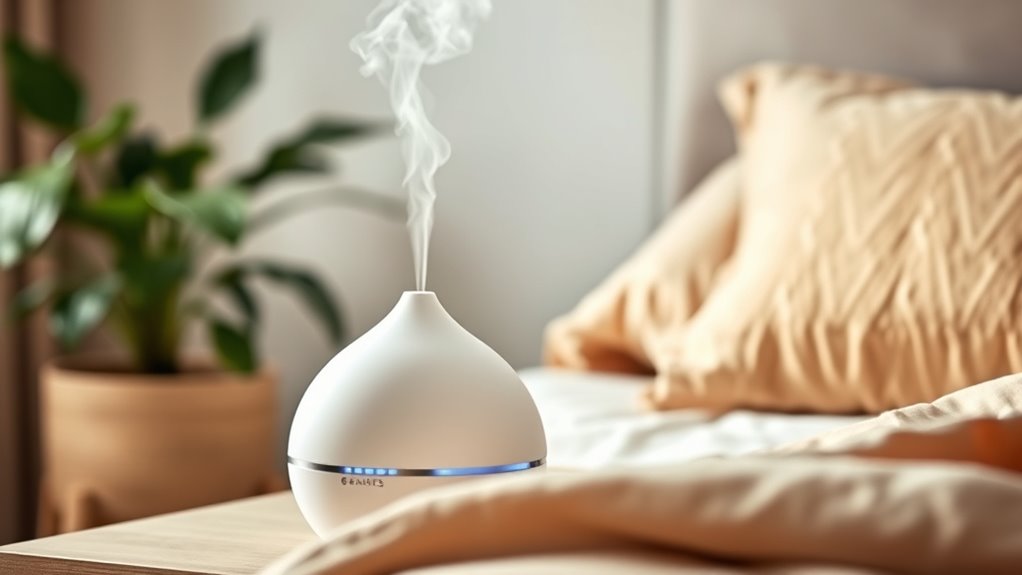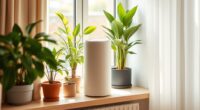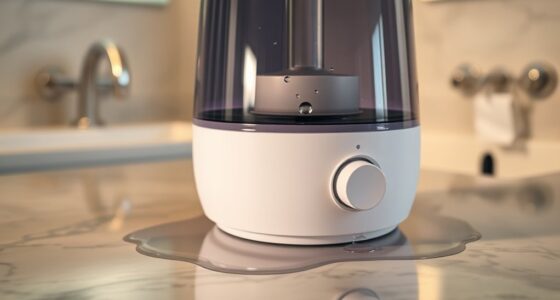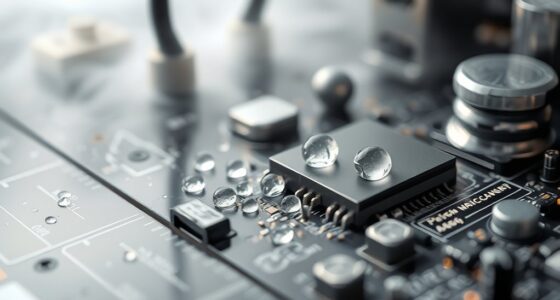Ultrasonic humidifiers are a great choice if you want quiet, energy-efficient moisture for your home. They produce a fine mist that quickly increases humidity, helping with dry skin and irritated sinuses. However, they need regular cleaning to prevent bacteria and mold growth, and using tap water can cause white dust. While perfect for small spaces and bedrooms, larger areas might need multiple units. Keep an eye on humidity levels for safe, effective use as you explore more about their benefits and tips.
Key Takeaways
- Ultrasonic humidifiers produce a silent, fine mist ideal for maintaining comfortable indoor humidity levels.
- They are energy-efficient and safer for households with children, as they don’t heat water or use fans.
- Regular cleaning and using distilled water prevent mold, bacteria, and mineral dust buildup, ensuring safe operation.
- They are best suited for small to medium spaces; large areas may require multiple units or alternative humidifiers.
- Proper humidity monitoring prevents over-humidification, reducing risks of mold, dust mites, and furniture damage.
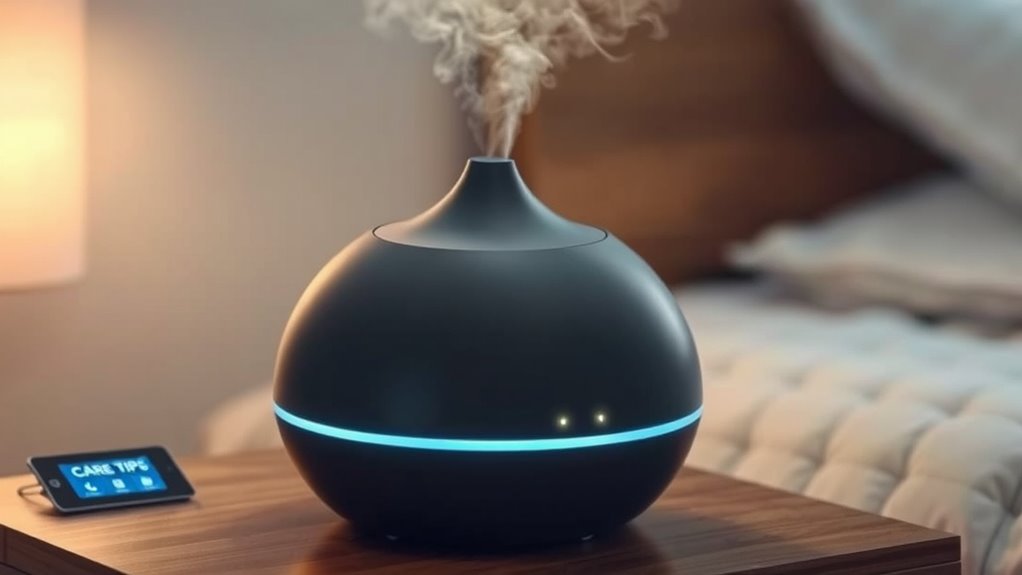
Are ultrasonic humidifiers the right choice for maintaining ideal indoor humidity? If you’re considering one, you’ll find these devices excel at producing a fine water mist that quickly adds moisture to dry air. Their ability to generate a cool, visible mist makes them popular for home use, especially during winter months when indoor air tends to become parched. One of their standout features is silent operation, which means you can enjoy the benefits of increased humidity without the constant hum or noise disruptions. This quiet functionality makes ultrasonic humidifiers ideal for bedrooms, nurseries, or workspaces where peace and tranquility matter.
Ultrasonic humidifiers quietly add moisture, making them perfect for bedrooms and nurseries.
When you turn on an ultrasonic humidifier, it uses high-frequency vibrations to turn water into tiny droplets, creating a mist that disperses evenly throughout your room. Because they rely on ultrasonic vibrations rather than fans or heating elements, they tend to be more energy-efficient and produce less noise. This water mist can quickly elevate the humidity levels, helping to alleviate dry skin, irritated sinuses, and respiratory discomfort. Plus, since they don’t heat the water, there’s less risk of burns or accidental injuries, making them safer for households with children or pets. Additionally, ultrasonic humidifiers can help improve indoor air quality by reducing airborne dust and allergens.
However, it’s important to understand that ultrasonic humidifiers require regular maintenance to prevent potential issues. The fine mist they produce can carry mineral particles from tap water, which may settle as white dust on nearby surfaces if you use hard water. To avoid this, you might opt for distilled or filtered water, though this adds to ongoing costs. Cleaning the device regularly is vital to prevent mold and bacteria buildup, which can be dispersed into the air along with the mist. Neglecting maintenance can lead to health issues or poor performance, so setting a routine cleaning schedule is essential.
While ultrasonic humidifiers are generally easy to operate, you should also be aware of their limitations. They tend to be less effective at humidifying large spaces compared to other types like evaporative humidifiers. If you’re in a big room, you might need multiple units or consider a different style. Additionally, because of the water mist they generate, there’s a slight chance of over-humidification if not monitored, which can lead to mold growth or damage to furniture. Using a hygrometer to keep an eye on humidity levels helps prevent these problems.
Frequently Asked Questions
Can Ultrasonic Humidifiers Help With Allergies?
You might find ultrasonic humidifiers helpful for allergies because they can improve humidity level control, which reduces airborne allergen levels. Maintaining proper humidity helps prevent dust mites, mold, and pet dander from thriving, easing allergy symptoms. However, make certain you clean your humidifier regularly to avoid mold growth. By keeping humidity balanced, you create a healthier environment that can lessen allergy triggers and improve your comfort indoors.
Are Ultrasonic Humidifiers Safe for Pets?
You wonder if ultrasonic humidifiers are safe for pets, and the answer depends. While they generally pose minimal risks, you should consider pet safety and ultrasonic noise levels. Pets might be sensitive to the consistent ultrasonic noise, which could cause discomfort. To keep your furry friends safe, make certain the humidifier is placed out of their reach and regularly cleaned to prevent mold or bacteria growth that could harm them.
How Often Should I Clean My Ultrasonic Humidifier?
Oh, the thrill of maintaining your ultrasonic humidifier—such excitement! You should clean it every 1-2 weeks to prevent mineral buildup and promote water tank maintenance. Neglect this duty, and you’ll invite mold and bacteria to party in your device. Regular cleaning with vinegar or mild soap keeps it running smoothly, ensuring fresh vapor. So, don’t skip this step—your humidifier and your lungs will thank you!
Do Ultrasonic Humidifiers Consume a Lot of Electricity?
Ultrasonic humidifiers generally don’t consume a lot of electricity, making them quite energy-efficient. You’ll find that their energy consumption is low compared to other appliances, which helps keep your utility bills manageable. Because of their cost efficiency, they’re a good choice for continuous use. If you want to save even more, consider using your humidifier only when needed and maintaining it well to guarantee peak performance.
Can Ultrasonic Humidifiers Be Used in Large Rooms?
While ultrasonic humidifiers are great for small to medium rooms, they aren’t always ideal for large spaces. Their humidification effectiveness depends on room size; in bigger rooms, they may struggle to distribute moisture evenly. You might need multiple units or a more powerful humidifier to achieve ideal humidity levels. So, for large rooms, consider the room size and humidity needs before choosing an ultrasonic humidifier for effective humidification.
Conclusion
While ultrasonic humidifiers bring soothing moisture and quiet operation into your home, they also require regular cleaning to prevent bacteria buildup. Their gentle mist can be a blessing during dry seasons, yet neglecting maintenance might turn this comfort into a health risk. So, as you enjoy the benefits of a perfectly humidified space, remember that proper care is essential—balancing the quiet relief you crave with the responsibility to keep your environment safe and healthy.
